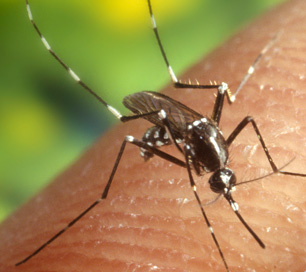Temephos

Temephos is used primarily to control mosquitos in non-potable waters.
Temephos is an insecticide primarily used as a larvicide to control mosquitoes in swamps, marshes, lakes, shallow ponds and other non-potable waters.
Human exposure is expected to be low due to its short half-life, but the World Health Organization reports that it may end up in drinking water when applied to water storage containers.
Health Effects of Temephos
According to the EPA, temephos can affect the human nervous system by inhibiting cholinesterase, causing symptoms of dizziness, confusion and nausea, and potential respiratory paralysis or death with exposure to large amounts.
A prison study involving relatively high doses (from an earlier ethical era) shows that this may not always be a concern:
In a study in human male volunteers who were prisoners, 10 men were given temephos at a dose of 1.1 mg/kg body weight per day for 4 weeks, and 9 men took temephos at a dose of 4.27 mg/kg body weight per day for 5 days. There was no inhibition of cholinesterase activity in the plasma or in erythrocytes.
Water Treatment for Temephos
The World Health Organization reports that although there is no documented water treatment for temephos removal, it “should be removed by adsorption onto activated carbon and possibly removed during coagulation.”
Sources: EPA, EPA (2), WHO, Photo: WikiMedia, author: James Gathany, CDC
Site Index
Filtration Systems
- Aeration for Iron & Sulfide
- Backwashing Filters
(whole house & well units)
- Chlorine & Chemical Injectors
- Countertop Water Filters
- Garden Hose Filters
- Reverse Osmosis, Residential
- Reverse Osmosis, Commercial
- Shower Filters
- Specialty Filters
- Ultraviolet Systems
- Undersink Filters
- Water Softeners
- Whole House Filters
Cartridges
Parts
- Replacement Parts
- Faucets
- Filter Media
- Fittings
- Housings
- O-rings
- Pumps
- Pura UV
- R.O. Parts
- R.O. Tanks
- R.O. Booster Pump
- VIQUA UV